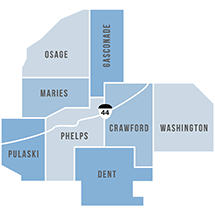What Is MRPC?
A Brief History
In 1965 the Missouri legislature adopted the State and Regional Planning and Community Development Act The act created the Missouri Department of Community Affairs (now called the Missouri Department of Economic Development) and authorized the governor to create regional planning commissions upon the petition of local governments. State statues say that if the governor finds a need for a regional planning commission in an area, and if the petitioning cities and counties in that area comprise more than half of the proposed region’s total population, then the governor may create a regional planning commission in that area. (Revised Statutes of Missouri, 1969, ed., Sec. 251.010, Sec. 251.030)
First Meeting
Local government leaders from each county in the region-Crawford, Dent, Gasconade, Maries, Phelps and Washington-first met on Sept. 24, 1968, at a park pavilion in Cuba, to organize the Meramec Regional Planning Commission. They chose Cuba Mayor John Brummet as temporary chairman to preside over the meeting. Two representatives from each county were chosen to form a bylaws committee, and an executive committee, also made up of two representatives from each county, was also formed.
Birth of an RPC
On Jan. 23, 1969, the Meramec Regional Planning Commission officially came into being. That day, Gov. Warren E. Hearnes signed the documents creating the MRPC and the commission elected its first officers: Salem Mayor Jack Masters as chairman; Leon Camillo, representative for Potosi, as vice chairman; Cuba Mayor John Brummet as secretary and Vienna Mayor Travis John as treasurer.
What Planning Is
Gov. Hearnes’ proclamation explained regional planning as “a means whereby municipalities and counties may work cooperatively to solve problems and to plan the future development of human, natural, and economic resources of a region” and called it “an indispensable guide to local units in accomplishing a coordinated and efficient development of the region which will best promote the public health, safety, general welfare and economic prosperity in accordance with existing and future needs.” According to state statutes, regional planning commissions “may conduct all types of research studies, collect and analyze data, prepare maps, charts and tables and conduct all necessary studies for the accomplishment of its other duties. In matters relating to comprehensive planning, a regional planning commission…may enter into a contract and cooperate with any federal, state or local unit including other planning commissions or organizations within this or other states under laws of Missouri.” (RSMo. 1969, Sec. 251.300,250.380.)
The Early Days
In the early days, the commission was run without a staff and without an office. The board members handled the business of organizing, and Chairman Jack Masters handled most of the administrative work out of his office in Salem. Monthly meetings were held at the Cuba City Hall. Funding came from the dues of member governments, which was set at 10 cents per capita. Eventually, the commission received federal planning grants and then needed to hire a staff to do the work. In March of 1971, the commission hired its first director, Harold Bray, and a few months later rented its first office, a temporary office located in the Holloway “House in Rolla”, 1008 Holloway St. By the Feb. 10,1972, meeting, the MRPC staff had moved into an office at 1203 E. l0th St. in Rolla. In May of 1976, the MRPC board voted to purchase a new building to better accommodate the growing organization, and soon thereafter the MRPC’s headquarters was moved to 101 W. 10 St. in Rolla. In July 1979, the MRPC hired its second director, Richard Cavender. The board voted to purchase a newer and more accommodating building in 1999 and the office moved to its current location at 4 Industrial Drive, St. James. On June 30, 2011, Richard Cavender retired after 32 years of service. The board named Bonnie Prigge executive director, staring July 1, 2011. Prigge had 20 years’ experience with MRPC and had served 15 years as assistant director under Cavender’s leadership.
Economic Development
A federal law, the Public Works and Economic Development Act, enacted in 1965, makes the Meramec Region eligible for federal aid because of the area’s relatively high unemployment and low family income levels. The law is designed to help stimulate the area’s economy by providing funding for community services. But the region wasn’t certified as a bona fide federal Economic Development District until 1975. Once the certification was made, the MRPC member governments became eligible for more public assistance to improve the local economy.
Addition of Osage County
On Nov. 13,1997, Gov. Mel Carnahan signed Executive Order 9714 that officially realigned MRPC’s boundaries to include Osage County. This was the first boundary change in the organization’s 28 year history. In 1998, the U.S. Department of Commerce Economic Development Administration admitted Osage County to the Meramec Economic Development District, making it eligible for economic development assistance like other Meramec communities and counties.
Addition of Pulaski County
On August 22, 2005, Governor Matt Blunt signed an executive order making Pulaski County a part of the Meramec Region – the second boundary change for MRPC.
The Mission
The Mission of MRPC is to enhance the quality of life for residents of the Meramec Region. In pursuit of this mission, MRPC will bring about results in these areas:
- Cleaner, healthier and safer communities.
- Greater socio-economic and cultural wealth through community and economic development, and
- A stronger, unified voice in the legislative process.

